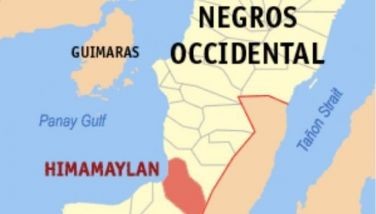‘Large lahars’ could still occur, expert warns
June 25, 2001 | 12:00am
CITY OF SAN FERNANDO, Pampanga  With the onset of the rainy season, a lahar expert warned that while the worst lahar threat may be over, "large lahars" could still be triggered at the Pasig-Potrero River in this province.
Dr. Kelvin Rodolfo, a consultant of the National Institute for Geological Studies (NIGS) who has been monitoring Mt. Pinatubo since its eruption in 1991, said, "It’s a mistake to assume that we will not anymore have large lahars."
"The eastern side of the Pasig-Potrero, facing San Fernando, seems to be under greater threat at present from lahar rather than the side (facing) Guagua and Sta. Rita (towns)," Rodolfo told The STAR.
While the U-shaped megadike was built at the Pasig-Potrero to trap lahar flows, Kelvin said the P1.4-billion still uncompleted structure "has yet to be tested by large lahars, the kind of extraordinary lahars that could be generated by really intense and prolonged rains."
"The other thing we have to worry about is complacency," he said, amid assurances from government engineers and some local leaders, whose business interests have been affected by the lahar threat, that the megadike is adequate to protect populated areas near the Pasig-Potrero.
"A lahar disaster is the result not only of a natural phenomenon. It can be exacerbated by overconfidence and diminished awareness of the threat on the part of the threatened population," Rodolfo warned.
He was apparently referring to the tragedy that killed scores of residents of Barangay Cabalantian in Bacolor in 1995 before the megadike was constructed.
At that time, local engineers and politicians assured barangay folk that they were safe from lahar flows after the so-called Gugu dike was completed across some portions of the Pasig-Potrero. The dike, however, collapsed and caught local folk unawares as lahar flows nine meters thick buried their homes.
Rodolfo cited two reasons why "it would be a mistake to assume that we will no longer experience large lahars."
"What generate large lahars are intense and prolonged rains which have yet to occur," he said. "Sooner or later, there will be extraordinarily heavy rains that would surely trigger large lahars."
"The other aspect we have to be wary about is believing that because lahar materials on Mt. Pinatubo’s slopes have been depleted, lahars will not happen anymore," Rodolfo said.
He cited the Cabalantian tragedy where the lahar materials that buried the village were largely materials that had been eroded from the slopes of Pinatubo and deposited at the upper channels of the Pasig-Potrero in Porac town.
"That was why people then marveled why the lahar flows that hit Cabalantian was cold and not hot," he said.  Ding Cervantes
Dr. Kelvin Rodolfo, a consultant of the National Institute for Geological Studies (NIGS) who has been monitoring Mt. Pinatubo since its eruption in 1991, said, "It’s a mistake to assume that we will not anymore have large lahars."
"The eastern side of the Pasig-Potrero, facing San Fernando, seems to be under greater threat at present from lahar rather than the side (facing) Guagua and Sta. Rita (towns)," Rodolfo told The STAR.
While the U-shaped megadike was built at the Pasig-Potrero to trap lahar flows, Kelvin said the P1.4-billion still uncompleted structure "has yet to be tested by large lahars, the kind of extraordinary lahars that could be generated by really intense and prolonged rains."
"The other thing we have to worry about is complacency," he said, amid assurances from government engineers and some local leaders, whose business interests have been affected by the lahar threat, that the megadike is adequate to protect populated areas near the Pasig-Potrero.
"A lahar disaster is the result not only of a natural phenomenon. It can be exacerbated by overconfidence and diminished awareness of the threat on the part of the threatened population," Rodolfo warned.
He was apparently referring to the tragedy that killed scores of residents of Barangay Cabalantian in Bacolor in 1995 before the megadike was constructed.
At that time, local engineers and politicians assured barangay folk that they were safe from lahar flows after the so-called Gugu dike was completed across some portions of the Pasig-Potrero. The dike, however, collapsed and caught local folk unawares as lahar flows nine meters thick buried their homes.
Rodolfo cited two reasons why "it would be a mistake to assume that we will no longer experience large lahars."
"What generate large lahars are intense and prolonged rains which have yet to occur," he said. "Sooner or later, there will be extraordinarily heavy rains that would surely trigger large lahars."
"The other aspect we have to be wary about is believing that because lahar materials on Mt. Pinatubo’s slopes have been depleted, lahars will not happen anymore," Rodolfo said.
He cited the Cabalantian tragedy where the lahar materials that buried the village were largely materials that had been eroded from the slopes of Pinatubo and deposited at the upper channels of the Pasig-Potrero in Porac town.
"That was why people then marveled why the lahar flows that hit Cabalantian was cold and not hot," he said.  Ding Cervantes
BrandSpace Articles
<
>
- Latest
- Trending
Trending
Latest


























